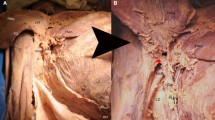Abstract
Purpose The present study aimed at summarizing and presenting the anomalous muscles that a surgeon might encounter during axillary lymphadenectomy (AL). Methods For this purpose, both the anatomical and surgical literature was reviewed and an anatomical study on 107 cadavers was carried out. Furthermore, based on the anatomical features of the anomalous muscles that came up during our study and taking into consideration the landmarks of the AL, we further analyzed the complications that may arise from each of these muscles, along with their preoperative and intraoperative recognition and management. Results The literature review revealed that there are three supernumerary muscles that may affect the AL, namely the Langer’s axillary arch, the pectoralis quartus and the chondroepitrochlearis muscles, as well as the aplasia of the lower part of the pectoralis major muscle. Eight out of the 107 (7.48%) cadavers that we dissected had such an abnormal muscle in the axilla. Specifically, the axillary arch was found unilaterally in five cadavers (4.67%) and the pectoralis quartus muscle was present unilaterally in three cadavers (2.8%). One cadaver had both an axillary arch and a pectoralis quartus muscle in the right side. The abdominal and almost the whole sternocostal portion of the pectoralis major as well the pectoralis minor muscle were absent in one cadaver (0.93%). The chondroepitrochlearis muscle was not found in any of the cadavers that we dissected. Conclusions The present study offers the necessary preoperative knowledge for recognizing these muscles during AL, avoiding thus the complications that may arise from them.


Similar content being viewed by others
References
Standring S (2005) Gray’s Anatomy, 39th edn. Elsevier, Edinburgh, p 962
Bergman RA (1991) Doubled pectoralis quartus, axillary arch, chondroepitrochlearis, and the twist of the tendon of pectoralis major. Anat Anz 173:23–26
Bergman RA, Afifi AK, Miyouchi R (2007) Pectoralis major and pectoralis minor. In: Illustrated encyclopedia of human anatomic variation, part I: muscular system. http://www.vh.org. Accessed Nov 2008
Bonastre V, Rodríguez-Niedenführ M, Choi D, Sañudo JR (2002) Coexistence of a pectoralis quartus muscle and an unusual axillary arch: case report and review. Clin Anat 15:366–370. doi:10.1002/ca.10053
Del Sol M, Olave E (2005) Elevator muscle of the tendon of latissimus dorsi muscle. Clin Anat 18:112–114. doi:10.1002/ca.20071
Georgiev GP, Jelev L, Surchev L (2007) Axillary arch in Bulgarian population: clinical significance of the arches. Clin Anat 20:286–291. doi:10.1002/ca.20369
Loukas M, South G, Louis RG Jr, Fogg QA, Davis T (2006) A case of an anomalous pectoralis major muscle. Folia Morphol (Warsz) 65:100–103
Mérida-Velasco JR, Rodríguez Vázquez JF, Mérida Velasco JA, Sobrado Pérez J, Jiménez Collado J (2003) Axillary arch: potential cause of neurovascular compression syndrome. Clin Anat 16:514–519. doi:10.1002/ca.10143
Rizk E, Harbaugh K (2008) The muscular axillary arch: an anatomic study and clinical considerations. Neurosurgery 63:316–319
Turgut HB, Peker T, Gülekon N, Anil A, Karaköse M (2005) Axillopectoral muscle (Langer’s muscle). Clin Anat 18:220–223. doi:10.1002/ca.20077
Yoshinaga K, Kawai K, Tanii I, Imaizumi K, Kodama K (2008) Nerve fiber analysis on the so-called accessory subscapularis muscle and its morphological significance. Anat Sci Int 83:55–59. doi:10.1111/j.1447-073X.2007.00169.x
Besana-Ciani I, Greenall MJ (2005) Langer’s axillary arch: anatomy, embryological features and surgical implications. Surgeon 3:325–327
Daniels IR, della Rovere GQ (2000) The axillary arch of Langer—the most common muscular variation in the axilla. Breast Cancer Res Treat 59:77–80. doi:10.1023/A:1006367904056
Kutiyanawala MA, Stotter A, Windle R (1998) Anatomical variants during axillary dissection. Br J Surg 85:393–394. doi:10.1046/j.1365-2168.1998.00612.x
Sachatello CR (1977) The axillopectoral muscle (Langer’s axillary arch): a cause of axillary vein obstruction. Surgery 81:610–612
Serpell JW, Baum M (1991) Significance of ‘Langer’s axillary arch’ in axillary dissection. Aust N Z J Surg 61:310–312. doi:10.1111/j.1445-2197.1991.tb00218.x
Haagensen CD (1986) Diseases of the breast, 3rd edn. W.B. Saunders Co, Philadelphia, pp 882–883
Tountas CP, Bergman RA (1993) Anatomic variations of the upper extremity. Churchill Livingstone, New York, pp 79–81
Clarys JP, Barbaix E, Van Rompaey H, Caboor D, Van Roy P (1996) The muscular arch of the axilla revisited: its possible role in the thoracic outlet and shoulder instability syndromes. Man Ther 1:133–139. doi:10.1054/math.1996.0261
Jelev L, Georgiev GP, Surchev L (2007) Axillary arch in human: common morphology and variety. Definition of “clinical” axillary arch and its classification. Ann Anat 189:473–481. doi:10.1016/j.aanat.2006.11.011
Flaherty G, O’Neill MN, Folan-Curran J (1999) Case report: bilateral occurrence of a chondroepitrochlearis muscle. J Anat 194(Pt 2):313–315. doi:10.1046/j.1469-7580.1999.19420313.x
Loukas M, Louis RG Jr, Kwiatkowska M (2005) Chondroepitrochlearis muscle, a case report and a suggested revision of the current nomenclature. Surg Radiol Anat 27:354–356. doi:10.1007/s00276-005-0337-4
Sarikcioglu L, Yildirim FB, Chiba S (2004) Unilateral occurrence of a chondroepitrochlearis muscle. Clin Anat 17:272–275. doi:10.1002/ca.10179
Mosconi T, Kamath S (2003) Bilateral asymmetric deficiency of the pectoralis major muscle. Clin Anat 16:346–349. doi:10.1002/ca.10077
Clark E (1915) Congenital variation of the pectoral muscles, with report of a case. J Anat Physiol 49:155–164
Spinner RJ, Carmichael SW, Spinner M (1991) Infraclavicular ulnar nerve entrapment due to a chondroepitrochlearis muscle. J Hand Surg [Br] 16:315–317. doi:10.1016/0266-7681(91)90060-2
Lin C (1988) Contracture of the chondroepitrochlearis and the axillary arch muscles. A case report. J Bone Joint Surg Am 70:1404–1406
Author information
Authors and Affiliations
Corresponding author
Rights and permissions
About this article
Cite this article
Natsis, K., Vlasis, K., Totlis, T. et al. Abnormal muscles that may affect axillary lymphadenectomy: surgical anatomy. Breast Cancer Res Treat 120, 77–82 (2010). https://doi.org/10.1007/s10549-009-0374-5
Received:
Accepted:
Published:
Issue Date:
DOI: https://doi.org/10.1007/s10549-009-0374-5




